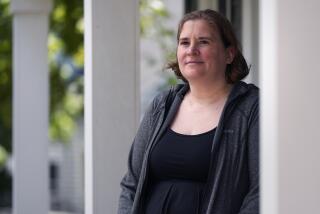School Lunches: Pass or Fail?
- Share via
Eight-year-old Oscar Rosales, who lives in a homeless shelter with his family, found himself in the unlikely position of testifying under bright lights at a federal hearing last week.
Visibly stunned by his predicament atop a stage in the cavernous auditorium of Los Angeles’ Fairfax High School, Rosales could barely utter a word before the large audience when the officials began asking his opinion.
But once he recovered from the initial shock, Rosales was able to provide expert witness testimony on the federally funded school lunch program at his 9th Street Elementary School in Downtown Los Angeles:
He doesn’t like it.
Rosales’ chin barely reached the table set on an auditorium stage decorated by banners, flags, draperies and camellias. Even so, he was convincing when he announced that neither he nor any of his classmates enjoyed the school’s ravioli. Too cheesy. Not enough flavor.
“We want,” he said, “something else other than ravioli.”
Rosales and the more polished witnesses that followed all seemed to want something other than what is being dished out to more than 25 million children each school day. (Another 4 million students participate in the related school breakfast program, as well.)
*
A circus-like variety of opinions came from famous chefs, distinguished physicians, prune growers, animal rights activists, school cafeteria workers and a handful of public school students, who appeared at the second of four hearings scheduled by the U.S. Department of Agriculture on revamping the nation’s $5.5 billion school lunch program.
Ellen Haas, USDA assistant secretary for Food and Consumer Services, presided over the day-long event in which about 90 people expressed their views on the hearing’s challenge: “Healthy Kids: Nutrition Objectives for School Meals.”
The Los Angeles session followed the release of a USDA study that found that the school lunch program fails to meet the recommendations of the Dietary Guidelines for Americans in terms of fat, saturated fat and sodium intake. According to the report, the program does meet the federal guidelines for cholesterol and most nutrients.
The USDA is considering regulations that would require the school breakfast and lunch programs to cut the fat, saturated fat and sodium content of meals. The department is motivated by considerable research that indicates obesity in children is linked to heart disease and other health problems in adulthood.
“Children, particularly those from low-income homes, are especially vulnerable to high-fat diets and chronic disease,” said Haas. “It is important to begin a low-fat diet early in life.”
The USDA hopes to improve the feeding program by, among other things, increasing the amount of fresh produce and lean meats served to children. At present, only a small fraction of the surplus food donated to the school lunch program by the federal government is in the form of fresh fruit and vegetables.
In announcing that the department wants to make nutrition a priority, top USDA officials have been highly critical of the current feeding effort. Agriculture Secretary Mike Espy, for instance, has been quoted as saying the school lunch program is giving children a head start on heart disease.
*
His comments infuriated local school food service workers who testified that they are hard pressed to present any meal service to students under extreme time and financial restraints, many of which are the result of USDA regulations.
At Fairfax High, for instance, the cafeteria staff is required to serve 1,700 students a nutritious lunch in just 30 minutes, but because of overcrowding, the food has to be the kind you can eat standing up, says Alita Rethmeyer, a registered dietitian with the California Dietetic Assn.
And, of course, there’s limited funding.
Schools are reimbursed $1.69 per lunch by the USDA for students whose household income--130% or less of the poverty line--qualifies them for free meals. The reimbursement drops to $1.29 1/2 for reduced-price lunches served to children whose families have income between 130% and 185% of the poverty line. All other children pay the full price of the lunch but the USDA still provides participating schools 16 cents reimbursement for these meals. If a school exceeds the federal reimbursement levels, they are required to pay the remaining balance.
Less than 40% of the lunches served in the United States were free, 7% were reduced price and 53% were full price in the 1991-1992 school year, according to the USDA study. On an average weekday, about 99% of all public schools and 83% of all schools participate in the program.
Anita Finch, a nutritionist from the Bellevue, Wash., school district said it would be difficult to stay within the proposed federal guidelines and still provide complete meals. Often the more nutritious choices are more expensive than their traditional counterparts. For instance, she said that a local supplier was selling her district low-fat hot dogs, or those with a 10% fat content, for $1.60 a pound. The regular hot dogs, with a 30% or more fat content, were only 60 cents a pound.
“We do not serve poison to our kids--contrary to the sensationalized comments from USDA,” said Ann Hale, president of the California Food Service Assn. and food service director for the Jurupa Unified School District in Riverside. “School food authorities are forced to generate revenue in order to stay in business (and must offer only those foods kids will buy) . . . Children are not asking for more fresh fruit and vegetables or for more bread . . . They want more pizza and (fast-food) branded entrees on the menu.”
*
Hale said that the only way to educate children about more nutritious eating is to offer nutrition classes as part of the curriculum and to promote foods that meet the dietary guidelines in every classroom. Still, Hale maintains that children that participate in the nation’s school lunch program are generally healthier than those that do not.
Richard DeBurgh, food service director for the Glendale Unified School District, was singled out by students as an innovative administrator--he’s even served escargot at schools. Yet, he also feels USDA has gone too far in criticizing the current program with its limited funding and bemoans the fact that his staff gets only seven seconds to serve each student during the school day’s restricted meal periods.
“I am not the enemy; I am part of the solution,” DeBurgh said at the hearing. “I am tired of being torn apart.”
Certainly, groups with a vested interest in such an enormous federal program are going to be concerned about any changes, USDA’s Haas said.
“The tremendous stake that the (food service representatives) have in the program collides with their perception,” she said. “The food service people need training and support in order to implement these changes . . . There is consensus on the need for USDA to continue in the direction of change and we’ve received great enthusiasm from many organizations.”
But school lunch administrators were not the only ones complaining about the USDA initiative. California canned food processors felt that they were being disparaged with the administration’s proposal to add more fresh produce to the school lunch room. They pointed out that canned fruits and vegetables are nutritionally equivalent to fresh, that they are picked at the peak of ripeness and are easier to store and transport than fresh.
Likewise, a representative of the Wheat Foods Council said the USDA did not emphasize the benefits of a diet rich in grain.
Probably the greatest departure from the typical debate on school lunch came when several prominent chefs testified on how to improve the program.
*
Alice Waters, owner of Chez Panisse in Berkeley, called for incorporating trades such as baking and vegetable gardening into a school curriculum so that students will get an appreciation of the entire food chain and the environment. She also lamented the time constraints forced on school lunch.
“How can we change kids’ attitudes about food when we only allow them less than half an hour to eat it?” Waters asked. “Children need the sensual, emotional and social education that comes from sharing and savoring good food, not from thoughtlessly gobbling some fast-food snacks shoved over the counter.”
Mark Peel, co-owner of Campanile restaurant in Los Angeles, went even further. He proposed permitting students to work in the cafeteria as part of teaching them how to cook.
“Unless you involve children in the preparation,” he said, “and teach them to understand why they should eat a healthy diet, then they will revert to the high-fat, high-salt diets that are now common.”
Haas welcomed the comments of both Waters and Peel, who operate upscale restaurants where dinner for two can cost $100.
“Their contribution,” she said, “is reinforcing the universal belief that unless food is appealing and tastes good then children are not going to eat it.”
caption
More to Read
Sign up for Essential California
The most important California stories and recommendations in your inbox every morning.
You may occasionally receive promotional content from the Los Angeles Times.










